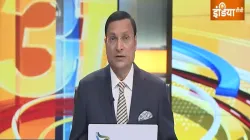OPINION | India-China Bhai Bhai: Welcome, but be careful
Details of the agreement that are unofficially available show that Indian and Chinese troops can now patrol within their borders in Depsang Plains and Demchok.

A day before Prime Minister Narendra Modi was due to have a first bilateral meeting in five years with Chinese President Xi Jinping in Kazan(Russia), a Chinese foreign ministry spokesman in Beijing confirmed that India and China have "solved relevant matters" (in eastern Laddakh). He said, China would work with India to implement it, but declined to provide details. Indian Foreign Secretary Vikram Misri announced on Monday that both countries have agreed on patrolling arrangements following negotiations to end the four-year-long standoff. Misri expressed hope that this may lead to the eventual disengagement of armies deployed on both sides of Line of Actual Control and eventually a resolution of disputes that arose in 2020.
Details of the agreement that are unofficially available show that Indian and Chinese troops can now patrol within their borders in Depsang Plains and Demchok. Troops of both countries can patrol their areas twice a month. To avoid any chance of confrontation, each patrolling team on both sides will not have more than 15 soldiers. Troops of both countries can patrol by staying 200-300 metres away from LAC.
Under the agreement, Indian and Chinese army commanders will coordinate with each other before sending their patrolling parties. The objective is to avoid the recurrence of the confrontation that took place in Galwan valley in May 2020, when 20 Indian soldiers were martyred and a large number of Chinese troops were killed. In July 2020, both armies had disengaged in Galwan and Hot Springs, and in 2021, they had withdrawn their troops in Gogra and Pangong Tso. But both troops have still locked in a close confrontation for the last four years at Depsang Plains and Demchok border points. Now, the agreement also covers both of these areas.
In Depsang, Indian troops can patrol upto Point 10 and Point 13, which had come to a standstill during the last four years. Chinese army will withdraw its troops from Depsang and dismantle its structures.
According to the agreement, troops of both countries will withdraw from LAC during winter, and for better coordination, commanders of both sides will have meetings every month. Though official details are not available, one must understand the broad meaning behind this agreement.
One, Chinese troops will return from those areas they had occupied four years ago, and the status quo situation of April, 2020, will be restored. A plan has been prepared for resolving the border standoff that has created tension. Two, the adverse effects on India-China bilateral trade that had taken place following the border standoff, will now end in a phased manner. There are many industrial sectors in India that are dependent on raw material procurement from China. These sectors can now heave a sigh of relief. Three, Congress leader Rahul Gandhi had been frequently raising the China border issue at his public meetings, while AIMIM chief Asaduddin Owaisi had been alleging that Chinese troops have occupied Indian territory. These leaders will now lose an issue that they have been raising frequently. Four, it seems that Russian President Vladimir Putin played an important role behind the scenes to bring about a reduction in tension between Modi's India and Jinping's China. India and China are the founder members of BRICS group. By ending tension on the border, they have conveyed an important message to those parts of the world which are facing conflicts. For example, Ukraine and Middle East.
In his bilateral meeting with President Putin on Tuesday, Modi stressed on the point that "war cannot be a solution for any dispute and solution can be arrived at only through negotiations".
Aaj Ki Baat: Monday to Friday, 9:00 pm
India's Number One and most followed Super Prime Time News Show 'Aaj Ki Baat- Rajat Sharma Ke Saath' was launched just before the 2014 General Elections. Since its inception, the show has redefined India's super-prime time and is numerically far ahead of its contemporaries.